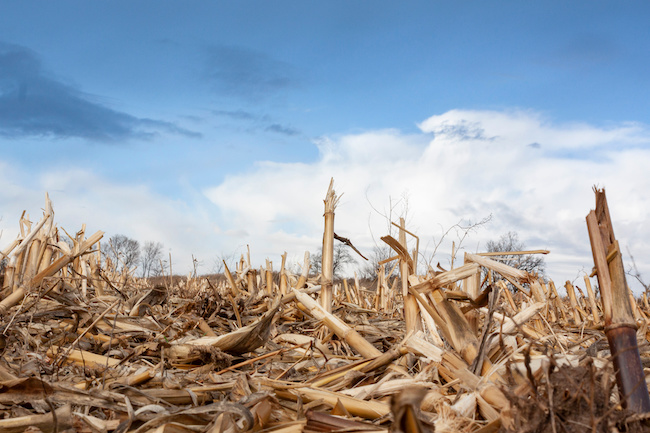Tough Soils, Yields Benefit from Gypsum, Elemental Sulfur
Oct 25, 2023

Consider these real-life examples of the benefits of gypsum and sulfur:
A Wright County, MN, grower had a field with heavy, tight soils and it wasn’t producing well. Soybean production was particularly poor. His Federated agronomist recommended using the age-old soil amendment product, gypsum, to address the difficult soil conditions. Gypsum is an extremely well-known and well-documented soil amendment that helps with soil aggregation and soil structure, especially when applied at higher rates.
Over several years, the tight and heavy soils were treated with gypsum at sulfur application rates (150-200 lbs./ac). And, since those rates were cumulative over time, the soils began to respond. This year, the grower said the field had “turned the corner” and was coming around to being more productive, “like they should be.”
Similarly, a Pine County grower had a field with poor drainage and tight soils, and his soybean yields were off. This year, after several years of gypsum applications, he claims that field has gone from “worst to first.” He had to work at it, but this year he saw about a 60 bu./ac. yield, which is more than a 50% improvement over yields prior to the gypsum applications.
Soybeans can be difficult on even good soils, but they are responsive to calcium and sulfur. Overall, crop yields continue to climb over time, and sulfur deposition from the atmosphere continues to decline.
It’s no surprise, then, that Federated Agronomists are seeing larger yield responses to sulfur applications. Sulfur sources include ammonium sulfate, elemental sulfur, and gypsum, and they “each have their pros and cons,” said Tim Stelter, Federated’s Osceola location manager.
“Sulfur (S) is the most important secondary nutrient needed after the three macro nutrients of N, P, and K,” he said.
Federated’s preferred gypsum product is SO4™ pelletized gypsum. SO4 can be applied anytime. SO4 is 17% sulfur and 21% calcium, which is also needed for crop growth, especially on alfalfa. It has the best of both worlds: some is readily available and some is slower release, and it is pH neutral.
“Elemental sulfur is an option for fall application because of its slow breakdown in the soil into the sulfate form,” said Stelter. At 90% sulfur, “a little goes a long ways; it’s the least expensive, but it will lower the pH over time,” he added.
Ammonium sulfate is for in-season application and is readily useable by crops but can lower the soil pH over time.
A fourth option is K-Mag®, a combination of potassium, magnesium, and sulfur for specific fertility needs (talk to your agronomist).
Got tough soils? Consider gypsum and/or sulfur applications this fall. Discuss your options with your Federated Agronomist.
A Wright County, MN, grower had a field with heavy, tight soils and it wasn’t producing well. Soybean production was particularly poor. His Federated agronomist recommended using the age-old soil amendment product, gypsum, to address the difficult soil conditions. Gypsum is an extremely well-known and well-documented soil amendment that helps with soil aggregation and soil structure, especially when applied at higher rates.
Over several years, the tight and heavy soils were treated with gypsum at sulfur application rates (150-200 lbs./ac). And, since those rates were cumulative over time, the soils began to respond. This year, the grower said the field had “turned the corner” and was coming around to being more productive, “like they should be.”
Similarly, a Pine County grower had a field with poor drainage and tight soils, and his soybean yields were off. This year, after several years of gypsum applications, he claims that field has gone from “worst to first.” He had to work at it, but this year he saw about a 60 bu./ac. yield, which is more than a 50% improvement over yields prior to the gypsum applications.
Soybeans can be difficult on even good soils, but they are responsive to calcium and sulfur. Overall, crop yields continue to climb over time, and sulfur deposition from the atmosphere continues to decline.
It’s no surprise, then, that Federated Agronomists are seeing larger yield responses to sulfur applications. Sulfur sources include ammonium sulfate, elemental sulfur, and gypsum, and they “each have their pros and cons,” said Tim Stelter, Federated’s Osceola location manager.
“Sulfur (S) is the most important secondary nutrient needed after the three macro nutrients of N, P, and K,” he said.
Federated’s preferred gypsum product is SO4™ pelletized gypsum. SO4 can be applied anytime. SO4 is 17% sulfur and 21% calcium, which is also needed for crop growth, especially on alfalfa. It has the best of both worlds: some is readily available and some is slower release, and it is pH neutral.
“Elemental sulfur is an option for fall application because of its slow breakdown in the soil into the sulfate form,” said Stelter. At 90% sulfur, “a little goes a long ways; it’s the least expensive, but it will lower the pH over time,” he added.
Ammonium sulfate is for in-season application and is readily useable by crops but can lower the soil pH over time.
A fourth option is K-Mag®, a combination of potassium, magnesium, and sulfur for specific fertility needs (talk to your agronomist).
Got tough soils? Consider gypsum and/or sulfur applications this fall. Discuss your options with your Federated Agronomist.